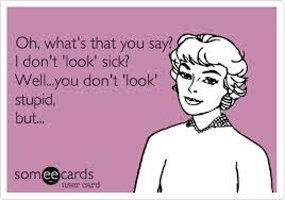Appearances are deceiving

Appearances are deceiving. Everyone has undoubtedly experienced some form of misunderstading, bias or disrespect from some form of misjudgement based on our appearance, sick or not. (Racism, sexism, agism). But the appearances of those with any form of Ehlers-Danlos Syndrome are especially deceiving, as the majority with it show no visible outward signs of illness at all. Every EDSer (aka “zebra” from here out) has heard some variation on any of the following and many more all our lives:
“But you look so good!”
“But you don’t look sick!”
“You’re how old? You don’t look ___ years old!”
“Your x-rays/ scans are clear”
“Your lab results are negative”
Etc., ad infinitum.
If only pain glowed, sigh. This disease is hard enough to live with to begin with, much less have to battle so hard to be diagnosed due to so much misinformation still abounding “out there” as I’ve already described at length. Can’t we just be allowed to suffer without being questioned? There’s even a website devoted to the second commonly heard phrase above: “But you don’t look sick!” for all suffering from chronic invisible illness, of which EDS is just one of too many (Lupus, Lyme Disease, MS etc. The list is long, alas). Add in how “good” we all seem to look (until some of us try to move), and you add insult to injury.
Not only do most of us suffer without any obvious outwardly visible signs of EDS, but for some unknown and ungodly reason our facial skin tends to look ridiculously and disproportionately young for our ages despite our faulty collagen, and we really suffer more than our share of invalidating dismissal and misunderstanding accordingly. No joke. People actually stroke my elderly aunt Kathleen’s face (she’s turning 90 this year) because her skin is “so soft!”. I’ve been mistaken for being at least 10 years younger than my age since my 20’s, and still am, despite the ravages of the last two years (and the previous 45). Toss in very little gray hair for me yet (I’m grateful for that, yes!) and people still think I’m just 30-something, though I’m sneaking up on 50 as I type.

“Nice problem” I hear you say. Well, not so fast baby duck. I’d trade you older looking skin in a heart beat for the undending pain and hard to diagnose and manage issues I’m struggling with now. Many subluxations (partial dislocations or “re-locations”, ones you’ve put back in) do not show on scans, much less x-rays. Neither do the myriad micro-tears and stretched tendons and ligaments that scream at me daily every time I bust a move. (I went from having only 3-5 or so tendons that hurt a lot “pre-storm” of 2012, to only 3 or less that don’t hurt much “post-storm” – if I can even find any). My right leg is still loose in its socket, causing my right foot to not work right so I can’t step “off” of it properly, but they’ve found nothing in a scan they can “fix”. Sigh.

You can’t tell my BP is on the floor or that I’m battling dizzyness or bone-dragging fatigue or brain fog when I’m sitting. About the only “sign” anything is wrong is when I flush nicely scarlet from a food allergy or mast cell reaction. Though I do at least turn gray and gasp like a fish when my ribs come out too far. (My friends have been trained to lay me down and keep me warm when this happens – I go into shock easily then). But I’ve gotten so good at avoiding that state, it doesn’t happen often. And I work hard to keep it that way.
Those with fibromyalgia pain know this lack of understanding perhaps better than anyone, since much like with Hypermobile EDS (or HEDS, which I think is what most with fibro really have actually, just subclinically), it can only be diagnosed clinically, that is to say through a trained physical exam in a doctor’s office based on rather subjective measures as reported by a patient. I.e, doctors have to take our word for how much we hurt, and not write us off as just anxious or depressed, even if we may be so in addition to being in terrific pain and exhausted. There’s still no simple single lab test – or even panel of tests – we can run to easily diagnose either condition (yet). Add in the red herring of bendiness I already complained about in my last post and it’s no wonder most of us get missed and dismissed. (Not all are bendy!)
But even our own families and friends can fail to appreciate the severity of this condition. When you suffer constant, never ending daily chronic and sometimes severe pain, you often stop complaining of it since a) everyone’s tired of hearing about it, including you, b) there’s not much more/else one can do about it, since we can’t escape our bodies and c) it doesn’t help much as anyone with chronic pain ultimately learns.
About the only outwardly visible sign many of us exhibit is another source of frequent misunderstanding: easy bruising. Along with frequent bone fractures (which should lead one to suspect Osteogenesis Imperfecta by the way), too many parents have been wrongly accused of child abuse due to the easy bruising of their hypermobile children leading to more misunderstanding. Our online support groups are rife with pictures of giant bruises on our legs and arms we’ve simply woken up with, as though visited by aliens in the night. Seriously. Thankfully I’ve found high doses of Vitamin C and magnesium to not only help me re-strengthen a bunch as it helps lay in new collagen (which I then “train up” right away through water therapy), it has nearly eliminated my easy bruising for likely the same reason: my capillaries are stronger. (Please consult your health care provider before starting any supplementation yourself!)
Toss in decreased mast cell reactions lowering my heparin levels through careful diet and lifestyle, and I could easily pass for an “orthotypical” now if I didn’t limp or struggle to open doors. But I looked very healthy, even athletic prior to my disabling onset “storm” of 2012. Like most fibro patients, you had to take my word for it that I was exhausted and in much pain. So I stopped complaining. But I’ll add that no one ever came over to watch me lying in bed recovering the next day after I went out with them. (I warn friends now to be sure to bring popcorn and a good book if they do, it’s really boring).

As mentioned elsewhere, I feel lucky though, since I did become more “visible” than most with EDS in 2012 – people stopped questioning and doubting me and my doctor now listens and takes me seriously. Finally, after over 25 long years of struggling to be heard and believed. But, it should not take anywhere near that long nor require such a degree of visible and severe disability for this to happen at all. Truly. By all rights I should have been diagnosed 25 years ago. So while EDS Awareness Month is over as I type this (June 1, 2014), we continue to fight to be recognized, diagnosed and supported daily even still. Please do your best to raise your “zebra-dar” and help spot more of us before more succumb.
Some not only stop complaining, they take their own lives from the lack of validation and understanding they repeatedly encounter among their family, friends and the medical community. (I myself considered this in years past). I am deeply grateful to all who seek to help raise awareness and recognition of this all too invisible illness that affects way too many, during any time of the year, not just May. And to all who choose to stand with us through our painful journeys of diagnosis and discovery, surviving with extremely painful loose bodies. May it return to you a thousand fold.
Humbly,
Jandroid 3.0



Reblogged this on Click And Color.